parking brake CHEVROLET ASTRO 1997 2.G Owners Manual
[x] Cancel search | Manufacturer: CHEVROLET, Model Year: 1997, Model line: ASTRO, Model: CHEVROLET ASTRO 1997 2.GPages: 404, PDF Size: 20.63 MB
Page 75 of 404
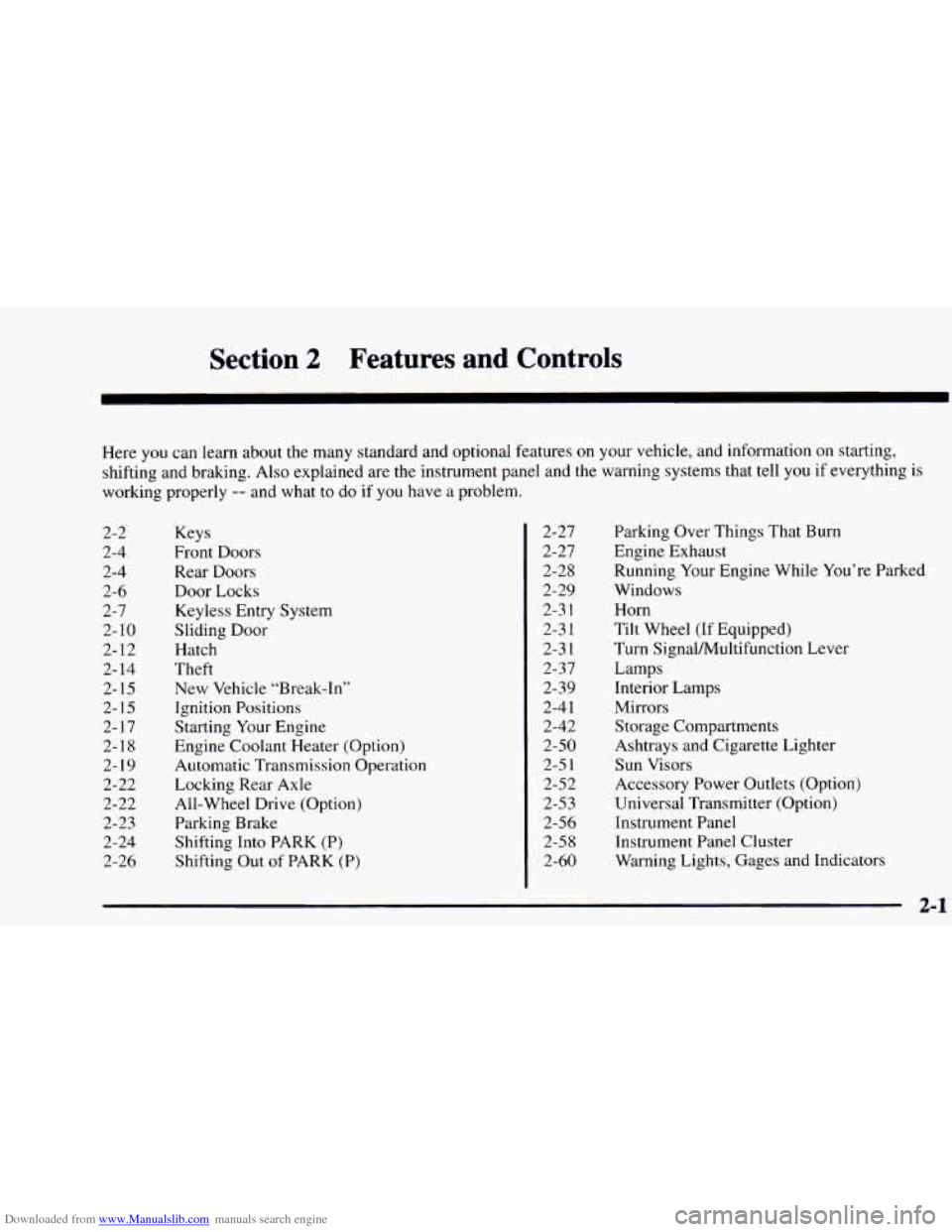
Downloaded from www.Manualslib.com manuals search engine Section 2 Features and Controls
Here you can learn about the many standard and optional features on your vehicle, and information on starting,
shifting and braking. Also explained are the instrument panel and the warning systems that tell you if everything is
working properly
-- and what to do if you have a problem.
2-2
2-4 2-4
2- 6
2-7
2-
10
2- 12
2-
14
2- 15
2-15
2- 17
2-1 8
2- 19
2-22
2-22
2-23
2-24
2-26 Keys
Front
Doors
Rear Doors
Door Locks
Keyless Entry System
Sliding Door
Hatch
Theft New Vehicle “Break-In”
Ignition Positions
Starting Your Engine
Engine Coolant Heater (Option)
Automatic Transmission Operation
Locking Rear Axle All-Wheel Drive (Option)
Parking Brake
Shifting Into PARK (P)
Shifting Out
of PARK (P) 2-27
2-27
2-28
2-29
2-3
1
2-3 1
2-3 1
2-37
2-39
2-4
1
2-42
2-50
2-5
1
2-52
2-5
3
2-56
2-58
2-60 Parking
Over Things That Burn
Engine Exhaust
Running Your Engine While You’re Parked
Windows
Horn
Tilt Wheel (If Equipped)
Turn Signal/Multifunction Lever
Lamps Interior Lamps
Mirrors Storage Compartments
Ashtrays and Cigarette Lighter
Sun Visors
Accessory Power Outlets (Option)
Universal Transmitter (Option)
Instrument Panel
Instrument Panel Cluster
Warning Lights, Gages and Indicators
2-1
Page 93 of 404
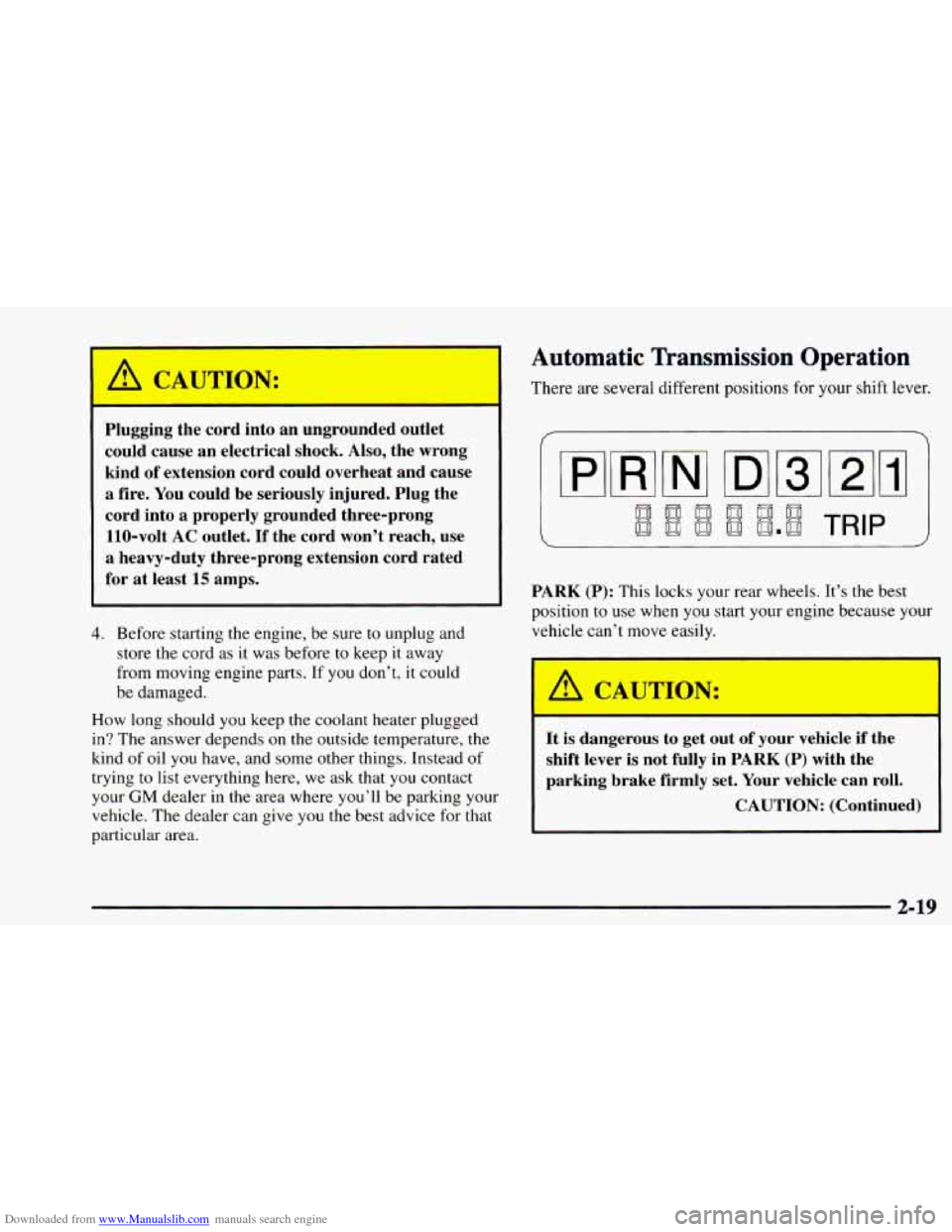
Downloaded from www.Manualslib.com manuals search engine A CAUTION:
Plugging the cord into an ungrounded outlet could cause an electrical shock.
Also, the wrong
kind of extension cord could overheat and cause
a fire. You could be seriously injured. Plug the
cord into a properly grounded three-prong 110-volt
AC outlet. If the cord won’t reach, use
a heavy-duty three-prong extension cord rated
for at least
15 amps.
4. Before starting the engine, be sure to unplug and
store the cord as it was before
to keep it away
from moving engine parts. If
you don’t, it could
be damaged.
How long should you keep the coolant heater plugged
in? The answer depends on the outside temperature, the
kind of oil you have, and some other things. Instead
of
trying to list everything here, we ask that you contact
your
GM dealer in the area where you’ll be parking your
vehicle. The dealer can give you the best advice for that
particular area.
Automatic Transmission Operation
There are several different positions for your shift lever.
PARK
(P): This locks your rear wheels. It’s the best
position to use when you start your engine because your
vehicle can’t move easily.
I A CAUTION:
It is dangerous to get out of your vehicle if the
shift lever is not fully in
PARK (P) with the
parking brake firmly set. Your vehicle can roll.
CAUTION: (Continued)
2-19
Page 94 of 404

Downloaded from www.Manualslib.com manuals search engine REVERSE (R): Use this gear to back up.
Don’t leave your vehicle when the engine is
running unless you have to.
If you have left the
engine running, the vehicle can move suddenly.
You or others could be injured.
To be sure your
vehicle won’t move, even when you’re on fairly
level ground, always set your parking brake anc
move the shift lever to
PARK (P).
See “Shifting Into PARK (P)” in the Index. If
you’re pulling
a trailer, see “Towing a Trailer”
in the Index.
Ensure the shift lever is
fully in PARK (P)
before starting the engine. Your vehicle has a
brake-transmission shift interlock.
You have to fully
apply your regular brakes before you can shift from
PARK
(P) when the ignition key is in the RUN position.
If you cannot shift out
of PARK (P), ease pressure on
the shift lever
-- push the shift lever all the way into
PARK
(P) as you maintain brake application. Then
move the shift lever into the gear
you wish. See
“Shifting Out of PARK (P)” in this section.
NOTICE:
Shifting to REVERSE (R) while your vehicle is
moving forward could damage your
transmission. Shift to
REVERSE (R) only after
your vehicle is stopped.
To rock your vehicle back and forth to get out of snow,
ice or sand without damaging your transmission, see
“Stuck: In Sand, Mud, Ice or Snow” in the Index.
2-20
Page 97 of 404
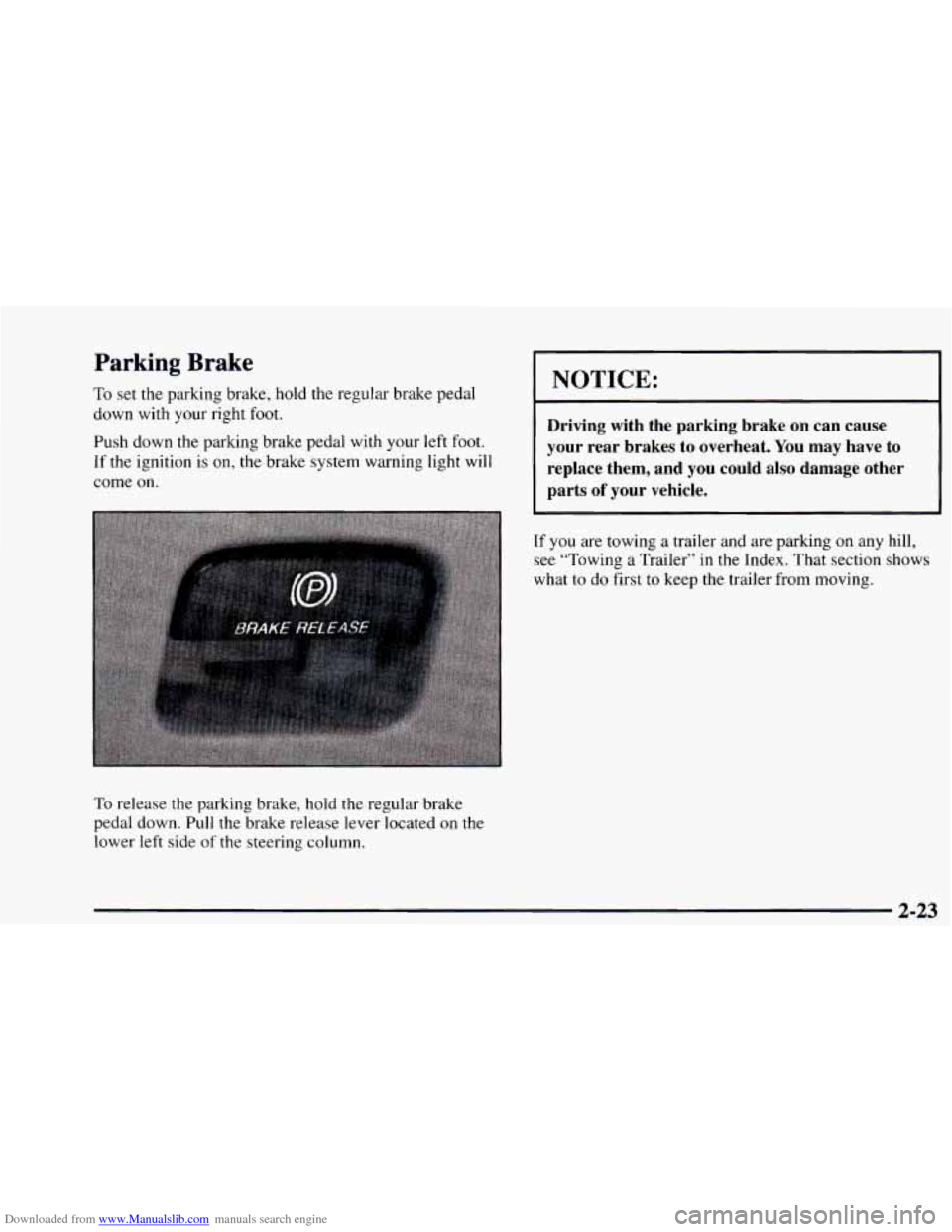
Downloaded from www.Manualslib.com manuals search engine Parking Brake
To set the parking brake, hold the regular brake pedal
down with your right foot.
Push down the parking brake pedal with your left foot.
If the ignition is
on, the brake system warning light will
come
on.
To release the parking brake, hold the regular brake
pedal down. Pull the brake release lever located on the
lower
left side of the steering column.
I NOTICE:
Driving with the parking brake on can cause
your rear brakes to overheat. You may have to
replace them, and you could also damage other
parts
of your vehicle.
If you are towing a trailer and are parking on any hill,
see “Towing a Trailer’’ in the Index. That section shows
what
to do first to keep the trailer from moving.
2-23
Page 98 of 404

Downloaded from www.Manualslib.com manuals search engine Shiftir: Into PARK (P)
A CAUTION:
It can be dangerous to get out of your vehicle if
the shift lever is not fully in PARK (P) with the
parking brake firmly set. Your vehicle can roll.
If you have left the engine running, the vehicle
can move suddenly. You or others could be
injured.
To be sure your vehicle won’t move, even
when you’re on fairly level ground, use the steps
that follow. If you’re pulling a trailer, see
“Towing
a Trailer” in the Index.
1. Hold the brake pedal down with your right foot and
set the parking brake.
2. Move the shift lever into the PARK (P) position
like this:
1
Pull the lever toward you.
2-24
Page 99 of 404
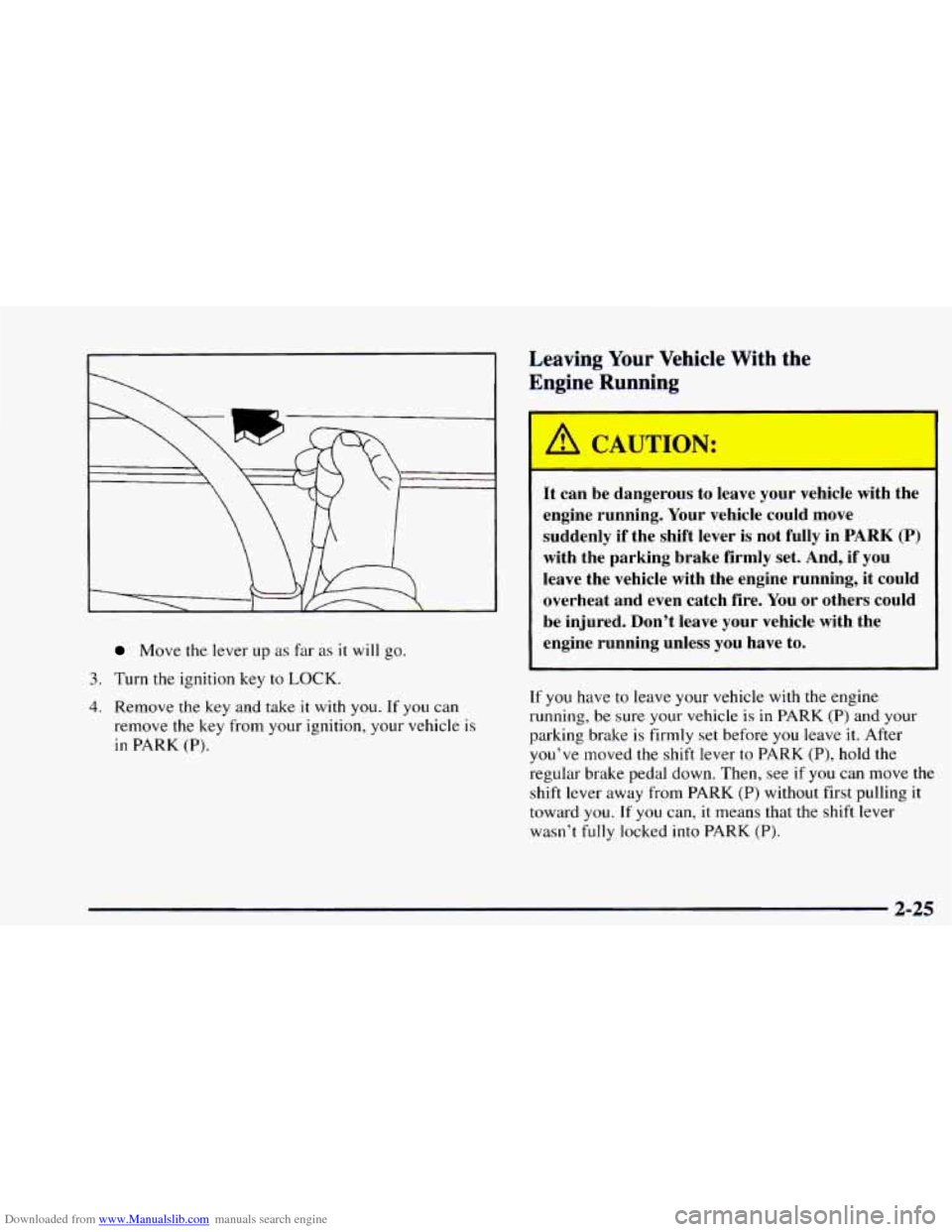
Downloaded from www.Manualslib.com manuals search engine Move the lever up as far as it will go.
3. Turn the ignition key to LOCK.
4. Remove the key and take it with you. If you can
remove the key from your ignition, your vehicle is
in PARK
(P).
Leaving Your Vehicle With the
Engine Running
It can be dangerous to leave your vehicle with the
engine running. Your vehicle could move
suddenly if the shift lever is not fully in
PARK (P)
with the parking brake firmly set. And, if you
leave the vehicle with the engine running, it could
overheat and even catch fire. You
or others could
be injured. Don’t leave your vehicle with the
engine running unless you have to.
If you have to leave your vehicle with the engine
running, be sure your vehicle
is in PARK (P) and your
parking brake
is firmly set before you leave it. After
you’ve moved the shift lever to PARK (P), hold the
regular brake pedal down. Then, see if
you can move the
shift lever away from
PARK (P) without first pulling it
toward you. If you can, it means that the shift lever
wasn’t
fully locked into PARK (P).
2-25
Page 100 of 404
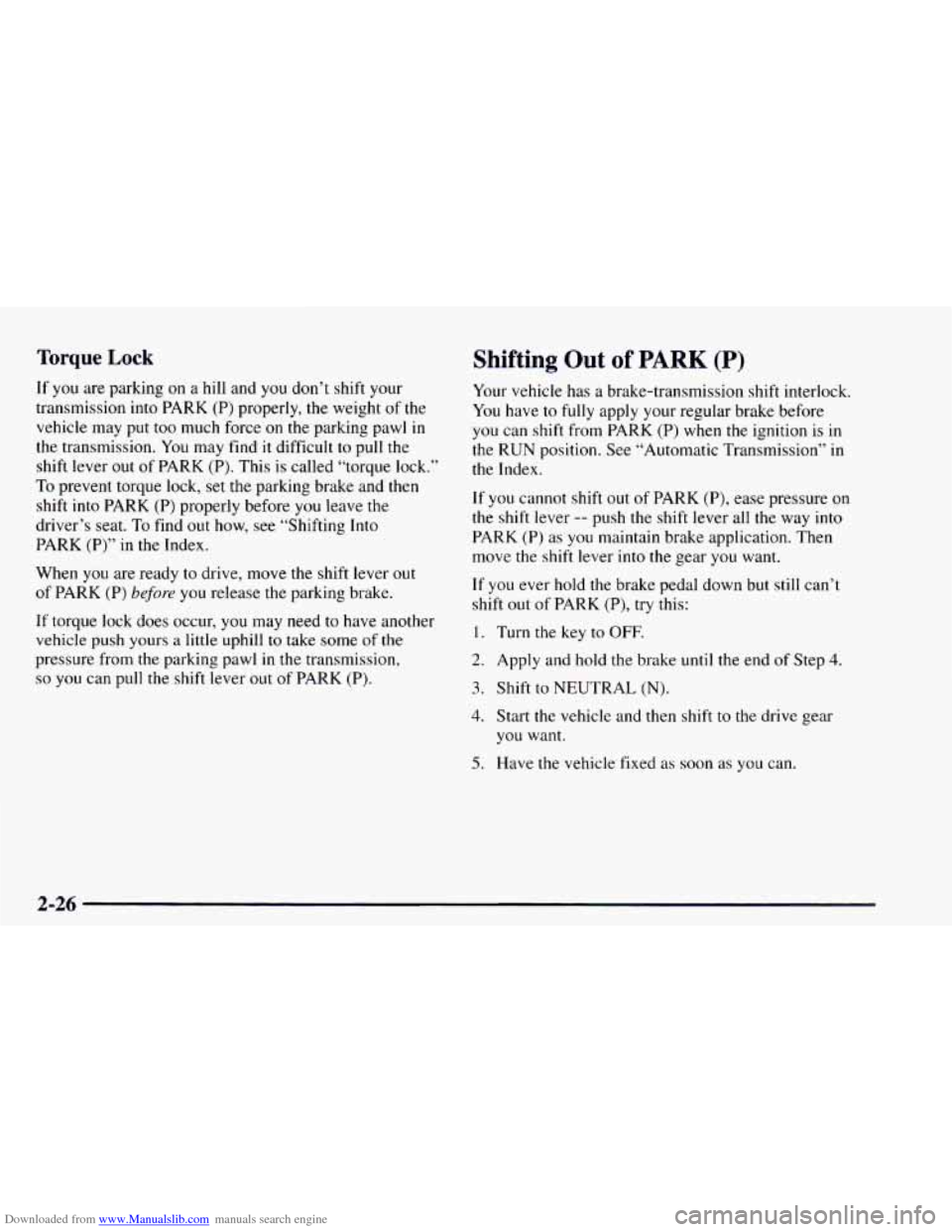
Downloaded from www.Manualslib.com manuals search engine Torque Lock
If you are parking on a hill and you don’t shift your
transmission into PARK (P) properly, the weight of the
vehicle may put too much force on
the parking pawl in
the transmission. You may find it difficult to pull the
shift lever out of PARK (P). This is called “torque lock.”
To prevent torque lock, set the parking brake and then
shift into PARK (P) properly before you leave the
driver’s seat. To find out how, see “Shifting Into
PARK
(P)” in the Index.
When
you are ready to drive, move the shift lever out
of PARK (P) before you release the parking brake.
If torque lock does occur, you may need to have another
vehicle push yours
a little uphill to take some of the
pressure from
the parking pawl in the transmission,
so you can pull the shift lever out of PARK (P).
Shifting Out of PARK (P)
Your vehicle has a brake-transmission shift interlock.
You have to fully apply your regular brake before
you can shift from PARK (P) when
the ignition is in
the
RUN position. See “Automatic Transmission” in
the Index.
If you cannot shift out
of PARK (P), ease pressure on
the shift lever
-- push the shift lever all the way into
PARK (P) as you maintain brake application. Then
move the shift lever into the gear
you want.
If you ever hold the brake pedal down but still can’t
shift out of PARK
(P), try this:
I. Turn the key to OFF.
2. Apply and hold the brake until the end of Step 4.
3. Shift to NEUTRAL (N).
4. Start the vehicle and then shift to the drive gear
you want.
5. Have the vehicle fixed as soon as you can.
2-26
Page 102 of 404

Downloaded from www.Manualslib.com manuals search engine Running Your Engine While
You’re
Parked
It’s better not to park with the engine running. But if
ever have to, here are some things to know.
Idling the engine with the air system control
off could allow dangerous exhaust into your
vehicle (see the earlier Caution under “Engine
Exhaust”).
Also, idling in
a closed-in place can let deadly
carbon monoxide (CO) into your vehicle even if
the fan switch is at the highest setting. One place this can happen is
a garage. Exhaust -- with
CO -- can come in easily. NEVER park in a
garage with the engine running.
Another closed-in place can be
a blizzard.
(See “Blizzard” in the Index.) It can
be dangerous
to get out of your vehicle if
the shift lever is not fully in
PARK (P) with the
parking brake firmly set. Your vehicle can roll.
Don’t leave your vehicle when the engine is
running unless you have to. If you%e left the
engine running, the vehicle can move suddenly.
You or others could be injured. To be sure your
vehicle won’t move, even when you’re on fairly
level ground, always set your parking brake and
move the shift lever to
PARK (P).
Follow the proper steps to be sure your vehicle won’t
move. See “Shifting Into
PARK (P)” in the Index.
If you’re pulling a trailer, see “Towing a Trailer” in
the Index.
2-28
Page 111 of 404
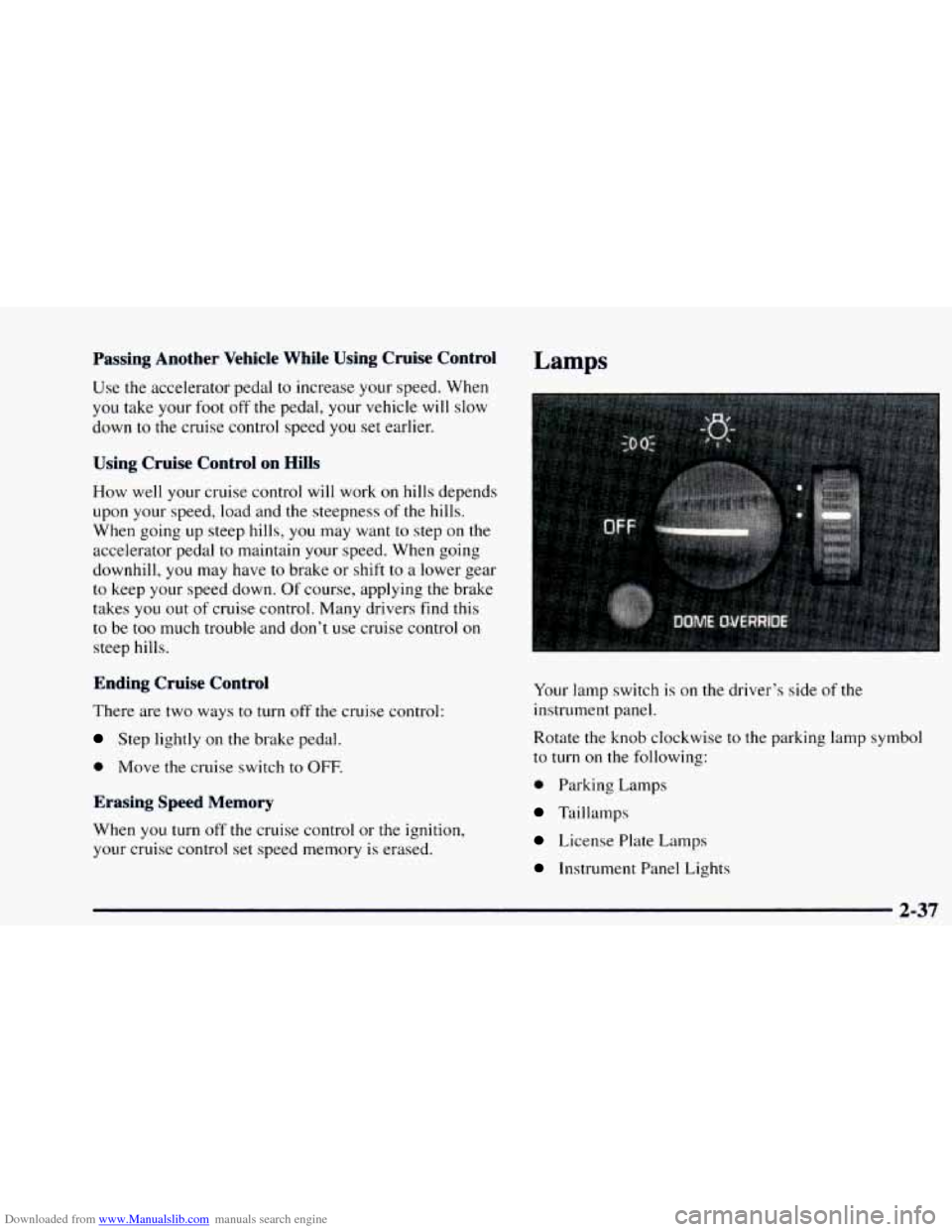
Downloaded from www.Manualslib.com manuals search engine Passing Another Vehicle Wh’- bing Cruise Control
Use the accelerator pedal to increase your speed. When
you take your foot off the pedal, your vehicle will slow
down
to the cruise control speed you set earlier.
Using Cruise Control on Hills
How well your cruise control will work on hills depends
upon your speed, load and the steepness
of the hills.
When going up steep hills,
you may want to step on the
accelerator pedal to maintain your speed. When going
downhill,
you may have to brake or shift to a lower gear
to keep your speed down. Of course, applying the brake
takes
you out of cruise control. Many drivers find this
to be too much trouble and don’t use cruise control on
steep hills.
Ending Cruise Control
There are two ways to turn off the cruise control:
Step lightly on the brake pedal.
0 Move the cruise switch to OFF.
Erasing Speed Memory
When you turn off the cruise control or the ignition,
your cruise control set speed memory
is erased.
Lamps
Your lamp switch is on the driver’s side of the
instrument panel.
Rotate
the knob clockwise to the parking lamp symbol
to turn on the following:
0 Parking Lamps
Taillamps
License Plate Lamps
Instrument Panel Lights
2-37
Page 112 of 404
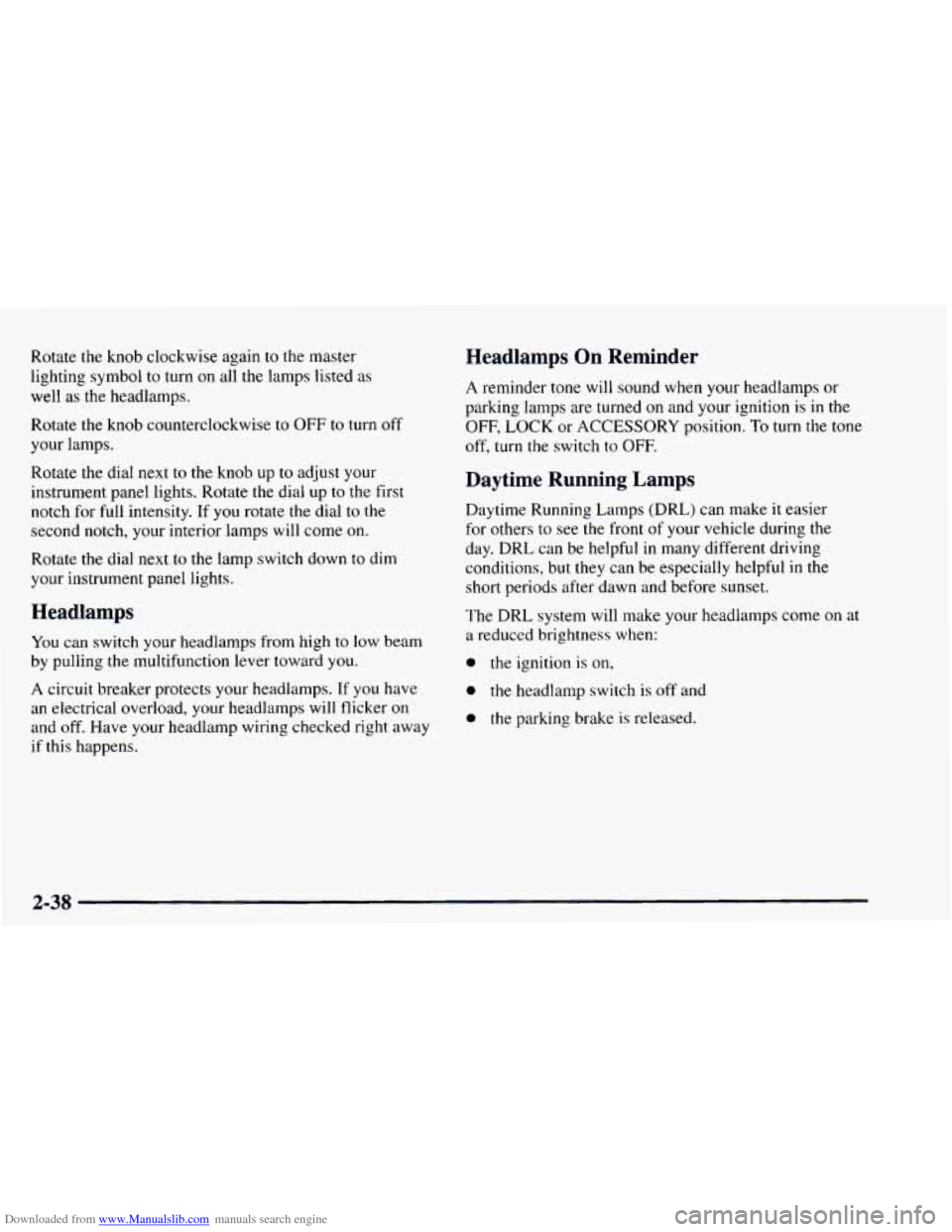
Downloaded from www.Manualslib.com manuals search engine Rotate the knob clockwise again to the master
lighting symbol
to turn on all the lamps listed as
well as the headlamps.
Rotate the knob counterclockwise
to OFF to turn off
your lamps.
Rotate the dial next to the knob up
to adjust your
instrument panel lights. Rotate the dial up
to the first
notch for full intensity.
If you rotate the dial to the
second notch, your interior lamps will come on.
Rotate the dial next to the lamp switch down
to dim
your instrument panel lights.
Headlamps
You can switch your headlamps from high to low beam
by pulling the multifunction lever toward
you.
A circuit breaker protects your headlamps. If you have
an electrical overload, your headlamps will flicker on
and off. Have your headlamp wiring checked right away
if this happens.
Headlamps On Reminder
A reminder tone will sound when your headlamps or
parking lamps are turned on and your ignition is
in the
OFF, LOCK or ACCESSORY position. To turn the tone
off, turn the switch to
OFF.
Daytime Running Lamps
Daytime Running Lamps (DRL) can make it easier
for others
to see the front of your vehicle during the
day. DRL can be helpful in many different driving
conditions, but they can be especially helpful
in the
short periods after dawn and before sunset.
The DRL system will make your headlamps come
on at
a reduced brightness when:
0 the ignition is on,
0 the headlamp switch is off and
0 the parking brake is released.
2-38